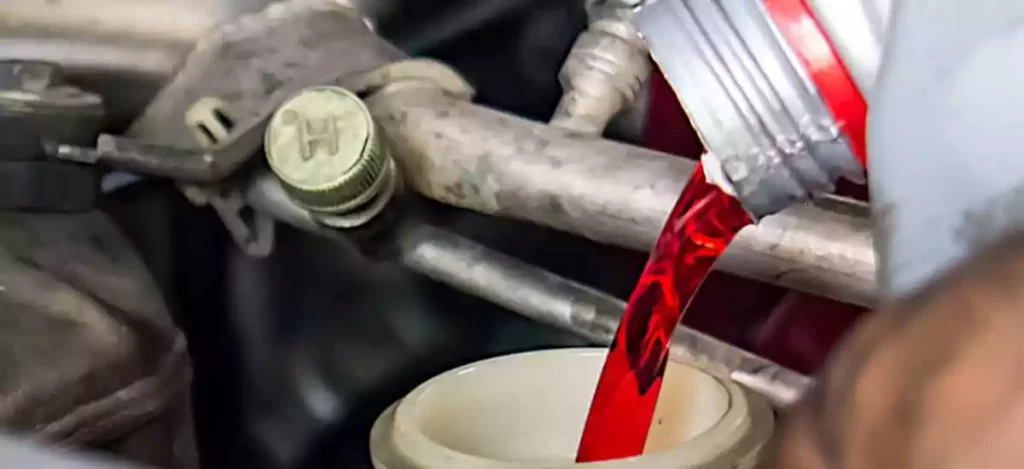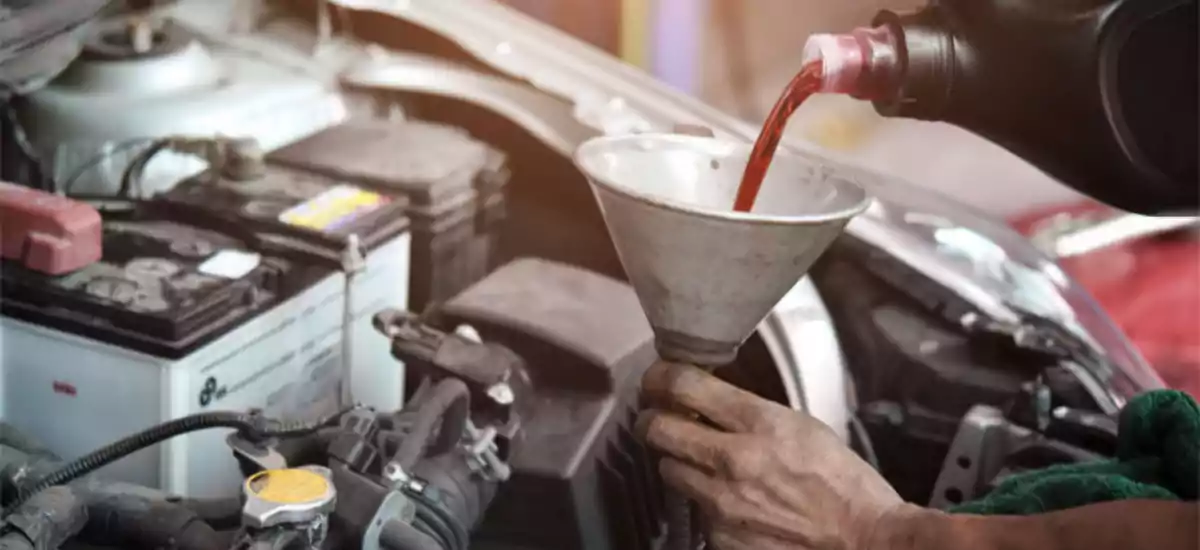Usually transmission fluid takes about 9 to 13 quarts to fill completely. The amount of transmission you add will vary, depending on whether you are draining or replacing it. The proper use of transmission fluid is one of the fundamental things that every car owner should be aware of. So cars require 9 to 13 quarts of transmission fluid but depending on the application around 3 to 6 quarts of Transmission Fluid you should add to the car.
But keep in mind that the fluid used in automatic transmissions differs from that used in manual transmissions. Automatic transmission fluid is a transmission oil that is only used in automatic vehicles meanwhile, manual transmission fluid is utilized in manual transmissions where the clutch is used during gear shifts.
Many car owners are not aware of how many quarts of transmission fluid they should add? In this article, learn about the transmission fluid additions and when and how much you have to change the fluid.
How Often to Change Transmission Fluid
Although it is not necessary to change the fluid of the car frequently, if your car has driven more than 20000 km to 50000 km then you should change the transmission fluid. Car owners must know when to change it and how many quarts they require. It is also necessary to monitor it and check it on a regular basis. It is also advisable to check the car manual before changing the fluid.
Being a car owner, you must keep an eye on the performance of your car. When you notice a small amount of decrease in performance of a car when shifting or engaging into gear then it is your time to change the transmission fluid. Check whether your transmission fluid level is low or the fluid has started to break down.

Due to a shortage of transmission fluid, internal gears and parts of the car may begin to rub together, potentially causing damage. Thus cars can stop abruptly or get jammed. This is the time and trigger for you that you have to change the transmission fluid.
Note – Transparent red color is the color of most new transmission fluids. A darker red or light brown color reveals the age and use of the oil. A darker brown color indicates that the fluid should be replaced. Thick Transmission fluid is also a sign of changing the fluid.
Purpose Of A Transmission Fluid
When it comes to vehicle performance, transmission fluid is an important part of the system’s functioning and overall execution. There are many benefits of transmission fluid that are as follows –
- Transmission fluid lubricates the bearings and metal parts to prevent them from grinding down while the car moves.
- It provides hydraulic pressure and friction to make the internal parts work in an automatic transmission.
- Transmission fluid, in both manual and automated transmissions, aids in the cooling of the transmission.
- Rust prevention in the parts of the mechanical system.
- Smooth-shifting
- Wear and tear prevention of transmission components
- Improved RPMs.
If your transmission fluid runs out completely, your automobile will most likely not go into gear, travel very slowly, or not shift at all. This is especially true if you drive a car with an automatic transmission. Allowing a car to become empty of transmission fluid will almost result in severe and costly repairs.
With these excellent qualities of transmission fluid, it is advisable for every car owner that he should fill his system with good transmission fluid.
Also Read :
5 Quick & Cheapest Ways to Fix Catalytic Converter,
What’s Causing Your Car to Squeal?
How Do I Check The Level Of My Transmission Fluid?
You can check the level of your transmission fluid by dipstick. It measures the amount of transmission fluid in your vehicle. Although most vehicles feature a transmission dipstick that you may use to check the levels. If you don’t know where the dipstick is and how to check the level of transition fluid please go through your user manual given by the manufacturer.
If you didn’t find a mechanic then pull the hood and park your automobile on a flat surface.
Turn on your car and leave it in the park for a few minutes to warm up the engine. Heat causes transmission fluid to expand, thus it must be at normal operating conditions to get correct results. If you check the fluid when the engine is cold, you could get incorrect readings that the fluid is low. While you’re checking the level, keep the engine running.
However, some latest car models are not coming with a dipstick, therefore it’s preferable to find a professional mechanic who can elevate the vehicle and inspect the fluid.
Where Is The Transmission Fluid Located?

Transmission fluid is often found in the gearbox near the oil dipstick in front-wheel drive vehicles and near the rear of the engine in rear-wheel drive vehicles. It is readily marked for access of the users, again you can check your car manual, if you didn’t find it
How Much Transmission Fluid Should I Add?
Initially, you should only pour roughly 1 quart of fluid at a time. The dipstick may appear full even when it is not as the fluid is cold. Thus it is necessary to start your engine while checking the level of fluid then only you will get to know the correct amount of transmission fluid and how low it is.
After the warmup of the engine, recheck the level once again. Add as much transmission fluid as you need until the dipstick reads full. According to the car type we have mentioned how many quarts of transmission fluid you should use in the car. Check it out
| Car Type | Volume in Quarts |
| City or Family Car, Sedan | 1.8 – 10.3 |
| Convertible, Roadster | 2 – 10.6 |
| Station Wagon or Touring Car | 1 – 9.5 |
| Electric /Eco Car (EV) | 1.5 – 4 |
| Hatchback, Liftback Car | 1.9 – 9.1 |
| Limousine | 9.5 – 12 |
| Minivan, Crossover Utility Vehicle (CUV) | 2 – 9.7 |
| Pickup, Commercial Vehicle | 2.2 – 12 |
| SUV | 3.5 – 17.1 US quarts |
Do You Leave The Car Running When Checking/Adding Transmission Fluid?
Yes, to check the fluid level most vehicles require the transmission to be warm, and the engine running. As we stated above, for checking the level of the car you must stand by your car on a flat surface and then you have to start the engine. This will heat up the engine and the remaining oil will expand.
Then again cool down the oil and measure the readings. By doing this you will get the correct measurement for how many quarts of transmission fluid you should add.
Check whether your parking brakes are on or not. At the time of adding the transmission fluid, you should keep the engine neutral. Note that Some automatic transmission fluid levels are monitored with the engine turned off.
How To Know If Your Transmission Is Overfilled
It is good to fill the transmission fluid to smoothly function your transmission system and to increase the performance of your car. But what about overfilling?
Car owners, you should always follow the general rule which states that never overfill the fluid. Overfilling of the transmission fluid will result in high system pressure. After this, the fluid begins to look for ways to escape and may end up leaking fluid from every viable source. Overfilling it will cause hard shifting and slippage in the transmission.
Another effect of overfilling your transmission fluid is that it loses its lubricating properties. It could also result in the entire system blowing up and ceasing to function.

How to detect when your vehicle is overfilled then these are the symptoms –
- Inadequate transmission within the crankshaft causes the engine to overheat.
- Excessive fluid levels cause part corrosion, failure, or damage owing to excess pressure.
- Transmission rebuild owing to seal failure.
- Vehicle breakdown.
- Overfilled transmission fluid will damage your seals and make them leak.
- Difficulties while shifting gear.
FAQ
1. How many quarts of transmission fluid?
Cars require 9 to 13 quarts of transmission fluid, however, depending on the use, 3 to 6 quarts should be added to the car.
2. How many bottles of transmission fluid do I need?
It takes 3.8 to 16 liters of transmission fluid to fill a standard car. Pickup and premium cars require the most transmission fluid, while green cars (eco and electric cars) and manual-transmission cars require the least. So if you have a 1-liter bottle you have then 4 to 16 bottles depending on the need and fluid level.
3. How much transmission fluid to add if empty?
If the transmission fluid has been drained out completely then 4 – 13 quarts of transmission fluid will be required to refill it. For the recommended type and amount of fluid, check your service manual or go-to mechanic for servicing. If the fluid level is very low when checked, add more fluid and inspect for leaks.
Transmission fluid leaks are the most common cause of low transmission fluid levels. There are a few points where leaks are widespread, from the seals to the driveshaft.
4. How often should you flush your transmissions?
A transmission flush may be required every 30,000 miles or every year, depending on the manufacturer or mechanic’s recommendation. A transmission flush basically ensures that there is no old fluid in the transmission of the car. It’s an excellent method for removing grease and dust from your transmission.
This maintenance procedure employs a specific machine that takes all of the old, dirty fluid from the transmission and replaces it with new, clean fluid.
Read More :
3 Best Practices for Managing a Small Fleet of Vehicles,
WHITE SMOKE FROM EXHAUSTEWHEN ACCELERATING

